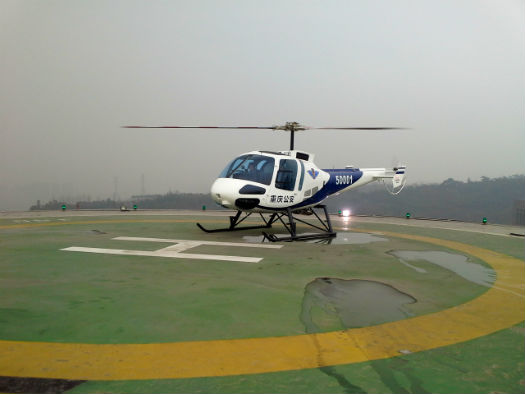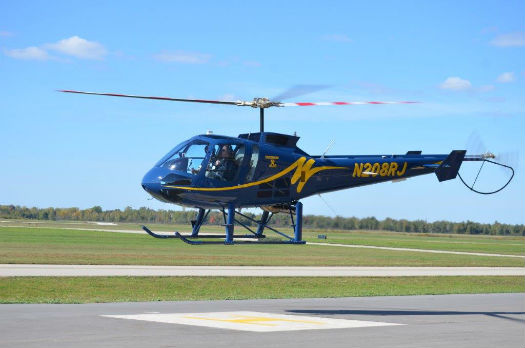
Enstrom is positioning itself for future growth in China, southeast Asia and other emerging markets. Shown here is the first Enstrom 480B in China with a police operator. Enstrom Photo
Enstrom Helicopter’s purchase in December 2012 by Chongqing General Aviation Group (CGAG) has benefited the helicopter manufacturer through an injection of capital that, among other things, allowed an expansion of the U.S. production plant in Menominee, Mich. While there are challenges that lie ahead, Enstrom is positioning itself for global expansion into emerging markets — with a bull’s eye squarely centered on China.
CGAG is currently pursuing a production certificate from the Civil Aviation Administration of China (CAAC) to build Enstrom variants in country. While the certification process runs its course, Enstrom is shipping kits from Menominee to CGAG in China.
During an interview for a feature article on Eastern Emerging Markets (see Vertical, December 2014/January 2015 print edition), Enstrom president and CEO Tracy Biegler described China as a “very different animal for us” when speaking of global expansion opportunities in various developing countries, and that’s directly related to the CGAG acquisition.
Enstrom became one of the first Western helicopter types to enter China in the early 1990s when an agricultural spray operator purchased a TH-28, the predecessor to the 480. Prior to the ownership change in December 2012, and just as authorities began talking about loosening up the airspace regulations, Enstrom sold 10 aircraft into China directly, according the Biegler. Since the acquisition, CGAG has been fully responsible for Enstrom sales and service in China.
“They’ve actually formed multiple aviation companies in support of their over-reaching goals, which is to bring general aviation to China in a big way,” Biegler explained. CGAG is the parent company of Chongqing General Aviation Industries (CGAI), which reassembles the kits that are shipped from Menominee; Chongqing General Aviation (CQGA), a maintenance arm; Chongqing General Aviation Training (CGAT); and Chongqing General Aviation Port (CGAP), which is building heliports and other aviation infrastructure in China. “What they’re trying to do is take a broad brush and cover everything in general aviation,” Biegler said.
By late 2014, Enstrom will have about 30 aircraft flying in China, many of which have been purchased through another one of CGAG’s divisions that serves as a dealer for the Chinese market.
CGAG’s goal when they purchased Enstrom in 2012 was to increase production to 50 helicopters in Menominee with another 50 assemblies sent to China, up until the company gains CAAC production approval. CGAG, then known as Chongqing Helicopter Investment Corp. (CQHIC), was tasked with finding a general aviation company ripe for purchase. They visited “every helicopter company you can think of,” Biegler noted. “They were looking anywhere and everywhere to purchase a company, but of course, there were very few on the market then outside Enstrom. So that’s really how that whole thing came about — not so much us going after them, but the timing was right between the two companies for the purchase.”

Enstrom delivered the first model 480B-G to Rick Boswell of New Hampshire in October. Enstrom Photo
According to Biegler, Enstrom sees four major areas where the Chinese market will begin to open up first — training, private pilots, police work and infrastructure support. “There’s a huge amount of population out there now that’s going to have the disposable income and a desire to fly, once you build that aviation culture,” he said. Biegler added the helicopter is “one of the better aviation platforms for police observation” and has seen continued service with agricultural spray operators, which involves including Isolair spray equipment as part of the shipment kit.
Enstrom has also established a network in Southeast Asia, including helicopters operating in Indonesia, Malaysia and the Philippines, in addition to fleet purchases from Japan and Thailand for military and government training.
Shift in Mentality
Biegler said Enstrom was having to change from a “completions center mentality to a production mentality — in other words, one or two aircraft a month versus trying to get four or five out every two weeks or more. You have to change some of the ways in which you produce aircraft.” That metamorphosis started under the leadership of former president and CEO Jerry Mullins, who retired in January 2014. Biegler continues to work with CGAG to develop production methodology, including new tooling and machinery, to reshape Enstrom and assist with setting up operations in China. He has also established a training program to help recruit new employees from within and outside the aviation industry as the company ramps up production.
“There’s been a lot of ideas here over the past few years that because of the ownership change — and it really was the input of the capital that helped us grow the facility and the other advancements — it gave us a boost of energy to take on some of the things that have been long-talked about.” One of those key pieces, he continued, is the TH-180 trainer. “With the seeming removal of the Schweizer 300 series, there’s a huge gap now in the training market.”
When Enstrom left the training market in the 1980s, Biegler remarked, the company “lost the feeder into our other customer base,” adding that re-establishing it is “going to be a game-changer for Enstrom in the long run.”
Enstrom and CGAG “are not just trying to capitalize on a short-term growth opportunity; we’re looking at a long-term investment and trying to grow the company into what all if us believe the product should be,” he said, adding that the process of getting there is “painful but good.”









